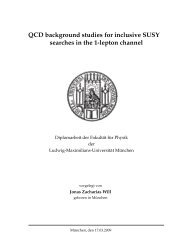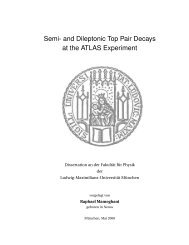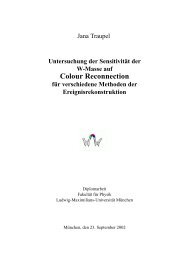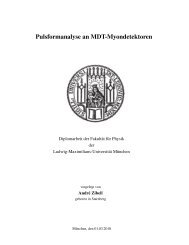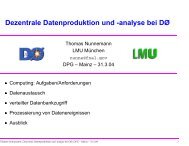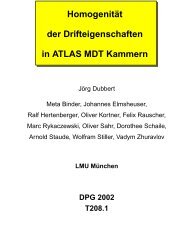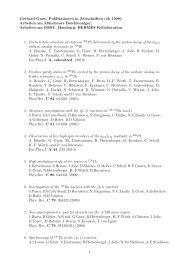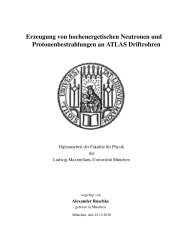development of micro-pattern gaseous detectors – gem - LMU
development of micro-pattern gaseous detectors – gem - LMU
development of micro-pattern gaseous detectors – gem - LMU
You also want an ePaper? Increase the reach of your titles
YUMPU automatically turns print PDFs into web optimized ePapers that Google loves.
Chapter 4<br />
Energy Resolution and Pulse Height<br />
Analysis<br />
This chapter addresses the analysis <strong>of</strong> measurements <strong>of</strong> cosmic muons as well as X-rays from a 55 Fe<br />
source. At first the resolution <strong>of</strong> pulse spectra resulting from a 55 Fe source is documented as it is<br />
obtained by prototype 1.0 for different anode geometries recorded by various preamplifiers. As Ch.<br />
4.2 illuminates, the resolution was found to depend on the source position. The following section<br />
about the energy distribution for cosmic ray muons completes the topic <strong>of</strong> energy resolution <strong>of</strong> the<br />
prototype 1.0. Ch. 4.4 treats the charge transfer processes in a GEM and the impact <strong>of</strong> the electric<br />
fields on it. Detailed measurements regarding the pulse height dependence on the electric field <strong>of</strong> the<br />
induction gap, Eind, can be found subsequently. After the installation <strong>of</strong> a five-fold segmented anode,<br />
we describe in Ch. 4.5 changes <strong>of</strong> the pulse height as a function <strong>of</strong> segmentation.<br />
4.1 55 Fe Pulse Spectra and Energy Resolution<br />
4.1.1 Spectrum Recorded with Unsegmented Anode Readout via CATSA82 Preamplifier<br />
As in Ch. 1.1.2 already covered, the photons generated by the 55 Fe decay carry mainly an energy <strong>of</strong><br />
Eγ = 6.50 keV, 5.90 keV and 2.68 keV. They interact with gas molecules due to the photoelectric<br />
effect. Recording these peaks in the spectrum <strong>of</strong> 55 Fe is the motivation <strong>of</strong> the following measurement<br />
in order to state the energy resolution <strong>of</strong> the triple GEM.<br />
The source is placed centrally above the active area as described in Ch. 3.1 and readout via the first<br />
trigger line with self-triggering detector. The lower scintillator (Sc1, cf. Ch. 3.4.1) is used as a<br />
veto-trigger for discriminating accidental recording <strong>of</strong> cosmic muons. In Fig. 4.1 the pulse height<br />
spectrum <strong>of</strong> 55 Fe is plotted as taken with the first setup <strong>of</strong> prototype 1.0, that is including an unsegmented<br />
Cu-anode and readout via the CATSA82 preamplifier. The peak on the left is due to remaining<br />
cosmics which traverse the detector under a large zenith angle without hitting the bottom scintillator.<br />
Their spectrum is fitted with a Landau distribution and will be reviewed in upcoming sections.<br />
The peaks <strong>of</strong> interest are the central and the right ones which represents the characteristic escape<br />
peak, the Kα line and the K β peak, respectively. For stating quantitatively the energy resolution, three<br />
Gaussian functions are fitted to the histogram:<br />
39



